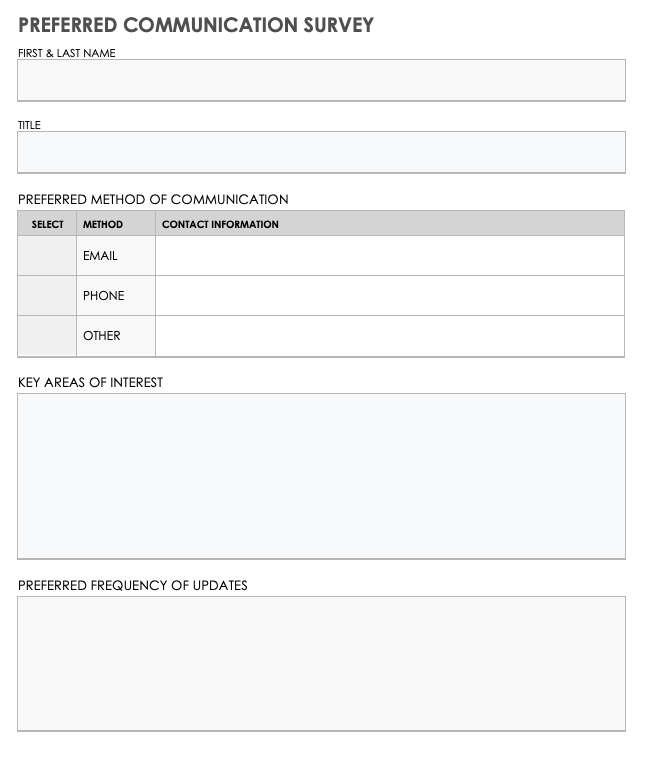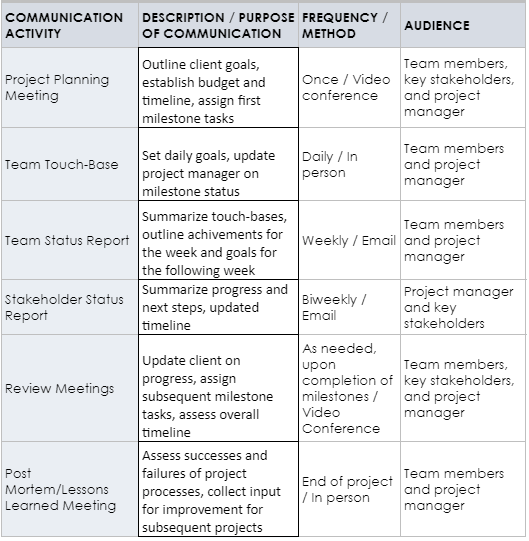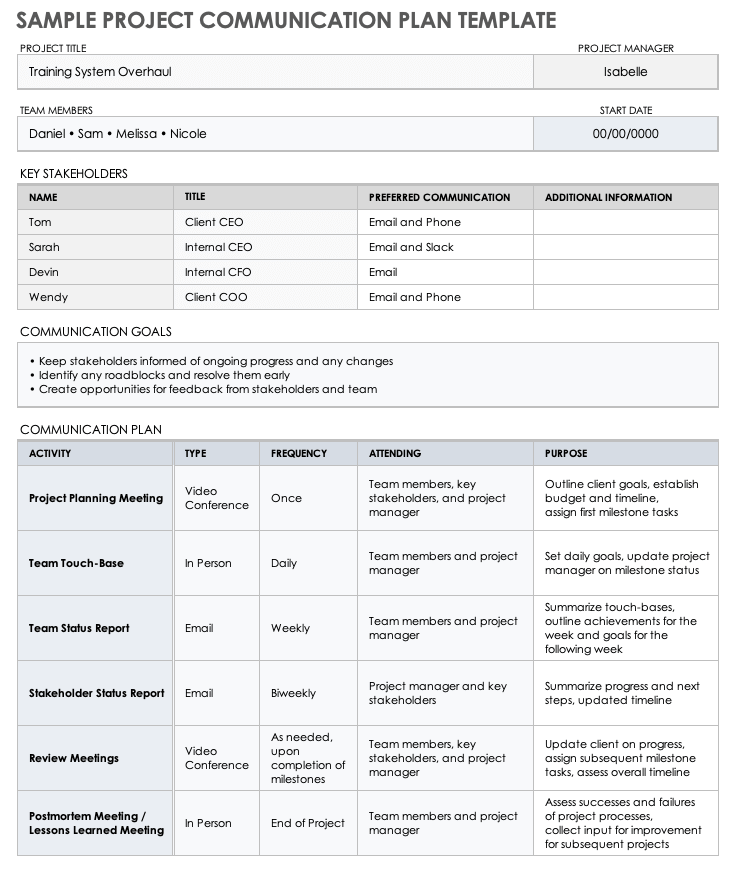What Is a Communication Plan for a Project?
A project communication plan is a guideline for dispensing details of a project to invested parties. An effective plan includes what kind of information will be distributed, to whom, and how often they will be updated.
Project Management Guide
Your one-stop shop for everything project management

Ready to get more out of your project management efforts? Visit our comprehensive project management guide for tips, best practices, and free resources to manage your work more effectively.
What Are the Important Elements of a Project Communication Plan?
While individual communication plans differ by project, all effective communication plans include scope, contact details, and more. Consider adding the following information to a communication plan:
- Type of Project: Name the project to make it easy to find and reference. Think about how long the project will take and the number of people involved when creating a meeting and update schedule. Larger projects will require more frequent and different meetings.
- Identify Key Players: Determine who is communicating, the type of information they are sharing, and who they are responsible for updating.
- Contact Information: Organize the contact details for stakeholders and team members to make communication easier and more organized.
- Frequency of Communication: Create a schedule for how you will share specific kinds of information. Alyssa Griffin, Service and Communications Specialist at Royal Building Products, recommends a measured approach. “Project updates are usually once a week at maximum. You don’t want to create a deluge of emails that individuals can lose or that can overwhelm them. Short and sweet works the best.”
- Types of Communication: You might find it advantageous to communicate types of information in varying ways. For example, some information may be best to share in real time through meetings or phone and video calls. In contrast, sometimes asynchronous methods such as email or company message boards are ideal. Read “The Essential Guide to Asynchronous Communication” to learn more about communication styles.
- Size and Scope of the Project: Different projects have different communication needs. Use a project scope template to define your project so that you can identify communication needs. For templates and more information, check out “Free Project Scope Templates.” Once you know the scope, consider preferred types of communication, especially for C-level stakeholders.
- Kristen Bellomo, Senior Project Manager at Bednark Studio, suggests using a survey at the beginning of a project to determine your stakeholders’ preferred communication styles and frequencies.
- Communication Goals: Look at past projects for specific processes to repeat or improve. Make sure to consider your findings from past post-mortem and lessons learned to ensure that you are establishing and implementing best practices.
Preferred Communication Survey
With help from Bellomo, we’ve created a survey to help you identify your key stakeholders’ preferred methods of communication during a project. This survey helps you easily collect and store the communication preferences of clients, stakeholders, and team members for use in your communication plan.
Preferred Communication Survey
- First and last name:
- Title and company:
- Key areas of interest:
- Preferred contact hours:
- Email address:
- Phone number:
- Instant message (Skype, Slack, Discord, etc):
- Video call:
Download Preferred Communication Survey Template
What Should a Communication Plan Include?
A communication plan is a series of documents that outline all formal communication shared throughout a project. Every successful communication plan should include details about stakeholders, meetings, and more.
- Key Stakeholders: These are the people who have a heavily vested interest in the project. They might be owners, clients, managers, or anyone else who needs regular updates on large-scale project developments. Read our guide to managing and communicating with stakeholders for more information.
- Team Members: These are the individuals working on the project. This also includes the project manager.
- Scheduled Meetings and Updates: Identify what’s important to communicate, including but not limited to deadlines, project phases, budget updates, and roadblocks. Consider the best way to share this information. For example, you might find that a weekly bulletin email update is more valuable for some items than a weekly meeting. If possible, create a meeting schedule early to ensure that people can attend. Utilize an online scheduling tool like Doodle to determine the best times for your team to meet.
- Specific Updates for Individuals: Pick out particular items of concern for key individuals. For example, C-level executives and clients might require opportunities to provide feedback at critical points, or they might only want updates after significant milestones.
- Evolve as the Project Progresses: Many projects suffer from scope creep or simply grow during the span of the venture. Be sure to account for any major changes in your communication needs as time goes on.
Video: How to Create a Project Communication Plan Using a Template

How to Write a Project Communication Plan in 6 Steps
Writing a communication plan doesn’t have to be a chore. Determine the communication needs of your team, identify the key players and what they need to know, and create a schedule that satisfies the needs of all parties.
- Determine Your Communication Needs
Consider the size and scope of the project, as well as the needs of your stakeholder, your client, and your team. Keep information relevant to the phase of the project and your audience.Bellomo emphasizes that some requirements will change based on the project phase. “There is typically frequent client communication (calls, emails, and in-person meetings) throughout the preproduction phase of the project while working through design and engineering. Client communication usually slows down after approvals, and the internal shop communication will ramp up for the project kickoff meeting and through production. Minimal client communication may happen through this phase, except for providing progress photos and updates throughout the build. Once build elements move into finishing, client communications usually ramp back up as we work through logistics and install details.” - Determine the Communication Goals for Your Team
Team cohesion? Early and ongoing feedback from stakeholders? Improved record keeping and ensuring best practices? These are just some of the goals you might set for yourself and the team. It is essential to consider your goals when outlining a schedule to create an effective plan. - Name the Project and Outline the Goals
By including the project goals on the plan, it is easier to check for scope creep as time passes. You can also ensure that you’re not wasting time and the updates and information you’re sharing aligns with the project’s goals from the outset. - Identify Key Stakeholders, Clients, and Team Members
List everyone who is involved in the project by name and title. Outline what you are communicating with each individual, as well as their preferred communication method and the frequency of your messaging. Use those details to create a communication matrix to assist in scheduling updates for key stakeholders and clients. Consider that methods and frequency might change based on the recipient and type of shared information.
- Create a Communication Schedule for the Project
Identify which meetings you plan to have, their purpose, and how often they occur. Determine the frequency of asynchronous updates such as email bulletins and project status reports, as well as what information they will include.
- Consolidate the Information into One Document
This document is your communication plan that you can share with the team. Go over the plan to give everyone an idea of what to expect and when to expect it.
Sample Project Communication Plan Template
Download Sample Project Communication Plan Template
Microsoft Excel | Microsoft Word | Google Sheets | Adobe PDF
You can use this example of a completed project communication plan as a reference when creating your own. This template highlights key stakeholders and their preferred contact information, types and frequency of interaction, and communication goals. Download and customize this template for use in your own projects.
In this article, we’ve compiled other most useful project communication templates to aid project managers with consistent messaging.
Best Practices for Writing a Project Communication Plan
The needs of every project vary, but all communication plans should be able to change throughout the process. Focus only on what is relevant to each individual, and take into account their preferred methods and frequency of communication.
- Be Open to Change: Keep an eye out for scope creep and don’t be afraid to update communication plans as projects evolve.
- Consider Preferences: Your clients and high-level stakeholders likely have preferences in their style and frequency of communication. Take those into account when sending updates.
- Focus on What Is Important: Keep the minutiae in an accessible place, such as a team message board or cloud-based drive, but only send out specific, necessary information to individuals.
- Consider the Needs of Parallel Teams: Bellomo highlights the importance of looking at the big picture: “I give the client and shop a written work-back schedule to outline when they can expect to receive information and what kind. This helps ensure everything is clear from the onset on what we need and when to achieve the established delivery schedule. For example, if I need vector files for a logo provided before engineering can commence, I would put the deadline for that unit earlier than the deadline for the rest of the artwork package that doesn’t impact the build and only involves the graphics finishing team.”
- Determine Your Tone: “It is important when establishing the initial communication with clients and the shop to be friendly and casual for the small stuff, but super detailed and outlined for the big stuff,” advises Bellomo.
- Delegate Clearly: Bellomo also suggests to “make sure action items are clear by breaking things down by element, action item, due date, and who is responsible for the task.” When someone is responsible for reporting updates, make sure they know it.
Importance of Communication Management in Project Management
A well-established communication plan is integral to managing the workflow of a project. By laying out the communication expectations from the outset, you can ensure that key stakeholders and team members stay in the loop.
Griffin notes that “setting early expectations for individuals and teams allows for better collaboration” throughout the course of a project. A communication plan can also ensure that team members stay accountable for relaying their own progress and achievements and that you have adequate time to provide and implement feedback during each stage of a project.
“Sticking to a standard allows individuals to know that they can come to you with any question and that you will assist them. Keep in mind that individuals are complex and have their own responsibilities while working on projects. Establish a communication schedule and follow up with an individual if they do not come through. If a delay arises, that is also OK; just make sure if there is a hiccup it is communicated clearly,” explains Griffin.
Benefits of a Project Communication Plan in Project Management
The benefits of a good project communication plan are far-reaching. You will stay more organized, build trust with your team and stakeholders, and ultimately end up needing to hold fewer meetings.
- Organization: At its most basic level, a communication plan will help keep you and your project schedule organized by plotting a course for upcoming meetings and check-ins.
- Team Cohesion: Keeping everyone in the loop fosters trust and helps you manage expectations. Griffin also emphasizes that “strong communication is a must, allowing for teams to collaborate, excel, and deliver the same level of service even while remote.”
- Stakeholder Input: When you have a communication schedule in place, you allow for early and ongoing feedback from key players attached to the project.
- Accountability: With a well-written plan, you can ensure that individuals stay accountable for reporting their work status and create a “paper trail” of reporting for higher-ups.
- Establish Confidence: Show the team and the higher-ups that you know what they need and when they need it.
- Fewer Meetings: Meetings take up a lot of time and resources. With a good communication plan, you can share information more often and in fewer meetings. Best of all, everyone will know exactly when to expect updates from the outset.
How to Use a Communication Plan Throughout a Project
Creating a comprehensive communication plan helps teams stay focused. No team is immune to scope creep, but with a communication plan, you can easily see where you're starting and recognize when goals no longer align with an existing plan.
Make sure the entire team has access to the plan and knows who is accountable for delivering and when. Your team will be able to help you see gaps in communication when everyone has access to the larger picture.
Don’t be afraid to change your plan. As issues come up — they always do — you can adapt your communication strategy much more easily when you have a system to reference. Keep your plan updated with contact information for stakeholders, frequency, and desired forms of communication as situations evolve.
Communication Activities in Project Management
Communication comes in many forms. Consider what you are sharing and who you are sharing it with, as well as their preferred communication methods.
- Formal Communication Activities: Email, meetings, scheduled phone and video calls, and bulletin updates can all be considered formal communication. Any kind of communication that is monitored or stored should be formal and professional.
- Informal Communication Activities: Watercooler or desk-side conversations and spur-of-the-moment phone calls are informal communication. Any kind of off-the-record communication is informal; if you establish an important point during one of these meetings, one or both parties should follow up by email to ensure that the conversation can be referenced later.
- Involuntary Communication Activities: Consider your tone of voice and body language when communicating with the team; these can both add emphasis to the words you say.
Power Up Your Project Communication Plan with Smartsheet
Empower your people to go above and beyond with a flexible platform designed to match the needs of your team — and adapt as those needs change.
The Smartsheet platform makes it easy to plan, capture, manage, and report on work from anywhere, helping your team be more effective and get more done. Report on key metrics and get real-time visibility into work as it happens with roll-up reports, dashboards, and automated workflows built to keep your team connected and informed.
When teams have clarity into the work getting done, there’s no telling how much more they can accomplish in the same amount of time. Try Smartsheet for free, today.




